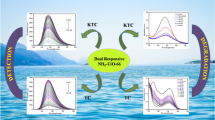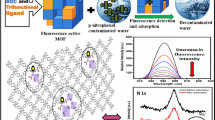Abstract
An amine-decorated zirconium based metal organic framework (MOF) UiO-66-NH2 with rod shape morphology was synthesized by solvothermal process using 2-aminoterephthalic acid as an organic linker. Crystallinity of synthesized MOF material was confirmed with PXRD technique. MOF was employed as selective and sensitive sensor for ultra-trace detection of 2,4,6-trinitrophenol (TNP) in aqueous matrix, even in coexistence with other competitive nitroaromatic analytes. High value of Stern-Volmer quenching constant Ksv (1.106 × 105 M− 1), plausible photoluminescent quenching efficiency (97.8%) and lower detection limit (0.95 µM/217ng mL− 1) ascertained extraordinary sensitivity of developed MOF for TNP. Density functional theory calculations and electrostatic interactions (i.e. ionic interaction, H-bonding and π-π interaction) indicated that electron and energy transfer processes play a key role in turn-off quenching response of UiO-66-NH2 sensor. Spiked real samples were analysed to validate the developed method, which satisfactorily established the developed MOF sensor as an efficient tool for analysis.
Graphical Abstract

Highlights
An amine-decorated zirconium based metal organic framework (UiO-66-NH2) was synthesised.
Developed sensor detected 2,4,6-trinitrophenol (TNP) in water samples.
Detection of TNP was done in presence of other potentially competitive nitroaromatic analytes.
Lower detection limit (0.95 µM/217ng mL− 1) ascertained extraordinary sensitivity of developed UiO-66-NH2 for TNP.
Electron and energy transfer processes justify the sensitivity of UiO-66-NH2 sensor for TNP.










Similar content being viewed by others
Data Availability
All the data associated with this research has been presented in this paper.
Code Availability
Not applicable.
References
Bhatt DR, Maheria KC, Parikh JK (2015) Highly efficient micellar extraction of toxic picric acid into novel ionic liquid: effect of parameters, solubilization isotherm, evaluation of thermodynamics and design parameters. J Hazard Mater 300:338–346
Han Y, Chen Y, Feng J et al (2017) One-pot synthesis of fluorescent silicon nanoparticles for sensitive and selective determination of 2, 4, 6-trinitrophenol in aqueous solution. Anal Chem 89:3001–3008
Chen X, Sun C, Liu Y et al (2020) All-inorganic perovskite quantum dots CsPbX3 (Br/I) for highly sensitive and selective detection of explosive picric acid. Chem Eng J 379:122360
Shen J, Zhang J, Zuo Y et al (2009) Biodegradation of 2, 4, 6-trinitrophenol by Rhodococcus sp. isolated from a picric acid-contaminated soil. J Hazard Mater 163:1199–1206
Takahashi M, Ogata H, Izumi H et al (2004) Comparative toxicity study of 2, 4, 6-trinitrophenol (picric acid) in newborn and young rats. Congenit Anom (Kyoto) 44:204–214
Barron L, Gilchrist E (2014) Ion chromatography-mass spectrometry: a review of recent technologies and applications in forensic and environmental explosives analysis. Anal Chim Acta 806:27–54
Lopez-Lopez M, Garcia-Ruiz C (2014) Infrared and Raman spectroscopy techniques applied to identification of explosives. TrAC Trends Anal Chem 54:36–44
Rahimi-Nasrabadi M, Zahedi MM, Pourmortazavi SM et al (2012) Simultaneous determination of carbazole-based explosives in environmental waters by dispersive liquid—liquid microextraction coupled to HPLC with UV-Vis detection. Microchim Acta 177:145–152
Yan F, He Y, Ding L, Su B (2015) Highly ordered binary assembly of silica mesochannels and surfactant micelles for extraction and electrochemical analysis of trace nitroaromatic explosives and pesticides. Anal Chem 87:4436–4441
Majumder S, Pramanik A, Mandal S, Mohanta S (2019) Experimental and theoretical exploration of sensing and magnetic properties of a triply bridged dicopper (II) complex: the first discrete metal complex to sense picric acid in pure water. J Photochem Photobiol A Chem 383:111987
Rong M, Lin L, Song X et al (2015) A label-free fluorescence sensing approach for selective and sensitive detection of 2, 4, 6-trinitrophenol (TNP) in aqueous solution using graphitic carbon nitride nanosheets. Anal Chem 87:1288–1296
Ju B, Wang Y, Zhang Y-M et al (2018) Photostable and low-toxic yellow-green carbon dots for highly selective detection of explosive 2, 4, 6-trinitrophenol based on the dual electron transfer mechanism. ACS Appl Mater Interfaces 10:13040–13047
Jiang S, Meng L, Ma W et al (2021) Morphology controllable conjugated network polymers based on AIE-active building block for TNP detection. Chin Chem Lett 32:1037–1040
Shellaiah M, Sun K-W (2021) Progress in metal-organic frameworks facilitated mercury detection and removal. Chemosensors 9:101
Olorunyomi JF, Geh ST, Caruso RA, Doherty CM (2021) Metal–organic frameworks for chemical sensing devices. Mater Horizons 8:2387–2419
Qiu Q, Chen H, Wang Y, Ying Y (2019) Recent advances in the rational synthesis and sensing applications of metal-organic framework biocomposites. Coord Chem Rev 387:60–78
Wang B, Lv X-L, Feng D et al (2016) Highly stable zr (IV)-based metal–organic frameworks for the detection and removal of antibiotics and organic explosives in water. J Am Chem Soc 138:6204–6216
Yu F, Du T, Wang Y et al (2022) Ratiometric fluorescence sensing of UiO-66-NH2 toward hypochlorite with novel dual emission in vitro and in vivo. Sens Actuators B Chem 353:131032
Peterson GW, Mcentee M, Harris CR et al (2016) Detection of an explosive simulant via electrical impedance spectroscopy utilizing the UiO-66-NH 2 metal–organic framework. Dalt Trans 45:17113–17116
Zhang N, Jin R, Mao G et al (2022) Nickle-Schiff base covalently grafted to UiO-66-NH2 as heterogeneous catalyst for ethylene oligomerization. Inorganica Chim Acta 531:120674
Liang Y, He J, Huang Z et al (2020) An amino-functionalized zirconium-based metal-organic framework of type UiO-66-NH2 covered with a molecularly imprinted polymer as a sorbent for the extraction of aflatoxins AFB1, AFB2, AFG1 and AFG2 from grain. Microchim Acta 187:1–8
Tambat SN, Sane PK, Suresh S et al (2018) Hydrothermal synthesis of NH2-UiO-66 and its application for adsorptive removal of dye. Adv Powder Technol 29:2626–2632
Pramanik S, Zheng C, Zhang X et al (2011) New microporous metal – organic framework demonstrating unique selectivity for detection of high explosives and aromatic compounds. J Am Chem Soc 133:4153–4155
Ma Y, Zhang Y, Kong L, Yang J (2019) Rational molecular design: functional quinoline derivatives for PA detection, gaseous acid/base switching and anion-controlled fluorescence. CrystEngComm 21:94–101
Ahmed R, Ali A, Ahmad M et al (2020) Phenanthroimidazole derivatives as a chemosensor for picric acid: a first realistic approach. New J Chem 44:20092–20100
Kumar V, Kumar A, Chini MK, Satapathi S (2021) Fluorescent Fe2O3-CdSe nanocomposite probe for selective detection and removal of picric acid. Mater Chem Phys 260:124130
Li Y, Wang D, Li S et al (2020) Magnetically separable Fe3O4@ Au@ Tb-MOF fluorescent probe with well‐designed Sandwich structure and metal‐enhanced fluorescence. ChemistrySelect 5:4028–4033
Singh R, Mitra K, Singh S et al (2019) Highly selective fluorescence ‘turn off’sensing of picric acid and efficient cell labelling by water-soluble luminescent anthracene-bridged poly (N-vinyl pyrrolidone). Analyst 144:3620–3634
Srivastava S, Gupta BK, Gupta R (2017) Lanthanide-based coordination polymers for the size-selective detection of nitroaromatics. Cryst Growth Des 17:3907–3916
Khatua S, Goswami S, Biswas S et al (2015) Stable multiresponsive luminescent MOF for colorimetric detection of small molecules in selective and reversible manner. Chem Mater 27:5349–5360
Dong S, Hu J, Wu K, Zheng M (2018) A mg (II)-MOF as recyclable luminescent sensor for detecting TNP with high selectivity and sensitivity. Inorg Chem Commun 95:111–116
Jin J-C, Wu J, He Y-X et al (2017) A 3D luminescent zn (II) MOF for the detection of high explosives and the degradation of organic dyes: an experimental and computational study. CrystEngComm 19:6464–6472
Acknowledgements
The authors are grateful to the Chemistry Department, Punjabi University, Patiala, for providing lab and instrument facilities.
Funding
Not applicable.
Author information
Authors and Affiliations
Contributions
Rajpal Verma and Gaurav Dhingra: Conceptualization, Methodology, Data curation, Writing - original draft, Visualization, Validation. Manpreet Kaur, Deepika Garg and Irshad Mohiuddin: Project administration, Investigation, Writing - original draft, reviewing and editing. Ashok Kumar Malik: Investigation, Project administration, Supervision, Formal analysis, Writing - review and editing.
Corresponding author
Ethics declarations
Ethics Approval
Not applicable.
Consent to Participate
Not applicable.
Consent for publication
Not applicable.
Conflict of Interest
The authors declare that they have no known competing financial interests or personal relationships that could have appeared to influence the work reported in this paper.
Additional information
Publisher’s Note
Springer Nature remains neutral with regard to jurisdictional claims in published maps and institutional affiliations.
Rights and permissions
Springer Nature or its licensor (e.g. a society or other partner) holds exclusive rights to this article under a publishing agreement with the author(s) or other rightsholder(s); author self-archiving of the accepted manuscript version of this article is solely governed by the terms of such publishing agreement and applicable law.
About this article
Cite this article
Verma, R., Dhingra, G., Kaur, M. et al. Amine-decorated Zirconium Based Metal Organic Framework for Ultrafast Detection of 2,4,6-Trinitrophenol in Aqueous Samples. J Fluoresc 33, 2085–2098 (2023). https://doi.org/10.1007/s10895-023-03216-0
Received:
Accepted:
Published:
Issue Date:
DOI: https://doi.org/10.1007/s10895-023-03216-0




